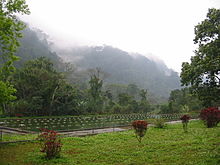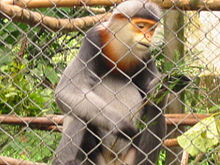- Cuc Phuong National Park
-
Cuc Phuong National Park (Vietnamese: Vườn quốc gia Cúc Phương) is located in Ninh Binh Province, in Vietnam's Red River Delta. Cuc Phuong was Vietnam's first national park and is the country's largest nature reserve. The park is one of the most important sites for biodiversity in Vietnam.
Map of Vietnam. Cuc Phuong National Park is marked in red. Ninh Binh Province is marked in black
Contents
History
In 1960 Cuc Phuong was made into a forest reserve and in 1962 Cuc Phuong National Park was consecrated by President Ho Chi Minh. Human habitation in Cuc Phuong dates back long before the park’s creation, 7,000-12,000 years ago. Artifacts from that time have been found in numerous caves within the park, including human graves, stone axes, pointed bone spears, oyster shell knives, and tools for grinding. In 1789 the Quen Voi section of the park was the site of a major battle in the civil war between Nguyen Hue and Thanh Long. More recently, conflicts have emerged between the government and 2,500 Muong ethnic minority tribesmen who live, farm, and hunt in the park. In 1987, 500 Muong were relocated outside of the park because of issues over poaching and land use.[1]
Landscape and climate
Cuc Phuong is situated in the foothills of the northern Annamite Mountains. The park consists of verdant karst mountains and lush valleys. Elevation varies from 150 meters (500 feet) to 656 m (2,152 feet) at the summit of May Bac Mountain, or Silver Cloud Mountain. The limestone mountains house numerous caves, many of which are accessible for exploration.
The average temperature in Cuc Phuong is 21 Celsius (70 Fahrenheit), with a mean winter temperature of 9C (48F). High temperatures can reach above 30C (85 F) and lows are just above zero (32 F). At the low elevations in the valley the temperature is hot and humid while at higher elevations the temperature drops and frostbite is a threat. On average it rains more than 200 days a year and the average annual rainfall is 2,100mm (7 feet). The dry season is November to February, the driest months being December and January. [1]
Flora and fauna
Cuc Phuong is home to an amazing diversity of flora and fauna. Inhabitants of the park include 97 species of mammals, most notable endangered langurs; 300 species of birds; 36 reptilian species; 17 species of amphibians; 11 species of fish; 2,000 species of vascular plants, and thousands of species of insects. A number of species in the park are listed on Vietnam Red Book of endangered species.
Primates in the park include macaques, gibbon, Francois' Leaf Monkey and slow loris. Other mammals including bats, porcupine, flying squirrel, small striped squirrel, belly-banded squirrel, and the rare Black Giant Squirrel. In the past the park was home to Asiatic Black Bears, wild dogs, and tiger, but over hunting and lack of prey have most led to the loss of these species. Leopard, clouded leopard and jungle cat may still be present in the park. [1]
Bird species include Bar-backed Partridge, Scaly-breasted Partridge, Silver Pheasant, Red Junglefowl, Grey Peacock Pheasant, Laughing Thrushes, Red-vented Barbet, Green-eared Barbet, Scimitar-billed Babblers, Brown Hawk Owl, Scarlet Minivet, Racket-tailed Drongos, Racket-tailed Treepie, White-winged Blue Magpie. Migrant species include thrushes, flycatcher[disambiguation needed
 ]s, tits, finches, pipits amongst others. Hornbills can also be spotted in the forest. [1]
]s, tits, finches, pipits amongst others. Hornbills can also be spotted in the forest. [1]An endemic sub-species of sub-terranic cave fish is also located in the park. [1]
Flora in the park includes multi-layered canopy; trees up to 70m in height; flowers, including, orchids; ferns with amazingly tall leaves; and an abundance of liane and cauliflory. The park also contains plants used for such practicalities as spices and medicines as well as edible fruits, nuts, and shoots. [1]
Conservation Programs
There are three conservation programs located in the Cuc Phuong National park:
Endangered Primate Rescue Center
The primate center houses specimens of langurs, loris, and gibbon species, include the critically endangered Delacour's Langur, Golden-headed Langur, Tonkin Snub-nosed Langur and Black Crested Gibbon. The primate center was established in 1993 with the help of the Frankfurt Zoological Society and has grown to 100 animals in 30 cages, 4 houses, two semi-wild enclosures.[2]
Carnivore and Pangolin Conservation Program
The Carnivore and Pangolin Conservation Program (CPCP) is dedicated to the conservation of small carnivores (civets, linsangs, small cats, weasels, otters and badgers) and pangolins in Vietnam. The program was established in 1995 as a species specific program for the endangered Owston's civet and has since expanded to include all species of small carnivore. In 2006 the program also began focused conservation activities for Vietnam's two species of pangolin, the Chinese pangolin and the Sunda pangolin. All of these species are threatened by the illegal wildlife trade which is having a devastating impact on the wild populations of these species throughout South East Asia.
The CPCP aims to conserve these threatened species of mammal through the rescue and rehabilitation of trade confiscated wildlife, education and awareness and field research. The CPCP also runs the region's only conservation breeding program for the Owston's civet, a species that is endemic to Indochina, and whose main range is within Vietnam.
The CPCP's main centre is within Cuc Phuong National Park, but operates a nationwide rescue program and has active field sites in Central and Southern Vietnam.
Turtle Conservation Center
The turtle conservation center was established in 1998 and is home to some of the most endangered turtles in Vietnam, including the Vietnamese Pond Turtle which is nearly extinct in the wild. [2]
Tourism
Cuc Phuong National Park is one of the most popular nature tourist destinations in Vietnam. Tens of thousands of Vietnamese and a steady stream of foreign tourists visit the park each year. Lodging and restaurant facilities are available at the park’s entrance and within the park. A paved road cuts into the park and a number of paths for hiking are maintained. Park rangers patrol Cuc Phuong and provide guided tours for a fee.
Other nearby tourist destinations located in Ninh Binh Province include Phat Diem Church, Hoa Lu Ancient Capital, Tam Coc - Bich Dong, Trang An, and Bai Dinh Pagoda.
References
- ^ a b c d e f "Appendix 7 Selected Protected Areas Accounts". World Conservation Monitoring Centre. Archived from the original on 2006-10-20. http://web.archive.org/web/20061020052520/http://www.wcmc.org.uk/infoserv/countryp/vietnam/app7.html. Retrieved 2006-07-07.
- ^ a b "Cuc Phuong Endangered Primate Conservation Center". Cuc Phuong Endangered Primate Conservation Center. http://www.primatecenter.org/center.htm. Retrieved 2006-07-07.
External links
- Cuc Phuong National Park
- Carnivore & Pangolin Conservation Program
- Cuc Phuong Turtle Conservation Center
- Cuc Phuong Endangered Primate Conservation Center
- Cuc Phuong National Park travel guide from Wikitravel
- Article on Cuc Phuong Biodiversity - World Conservation Monitoring Centre
- Vietnam National Parks & Reserves
- Cuc Phuong National Park - Ninh Binh
National parks of Vietnam Ba Bể · Ba Vì · Bạch Mã · Bái Tử Long · Bến En · Bidoup Núi Bà · Bù Gia Mập · Cát Bà · Cát Tiên · Chư Mom Ray · Chư Yang Sin · Côn Đảo · Cúc Phương · Hoàng Liên · Kon Ka Kinh · Lò Gò-Xa Mát · Mũi Cà Mau · Núi Chúa · Phong Nha-Kẻ Bàng · Phú Quốc · Phước Bình · Pù Mát · Tam Đảo · Tràm Chim · U Minh Hạ · U Minh Thượng · Vụ Quang · Xuân Sơn · Xuân Thuỷ · Yok ĐônCoordinates: 20°19′00″N 105°36′30″E / 20.3166667°N 105.60833°E
Categories:- National parks of Vietnam
- Thanh Hoa Province
- Ninh Binh Province
- IUCN Category II
- Protected areas established in 1960
Wikimedia Foundation. 2010.


